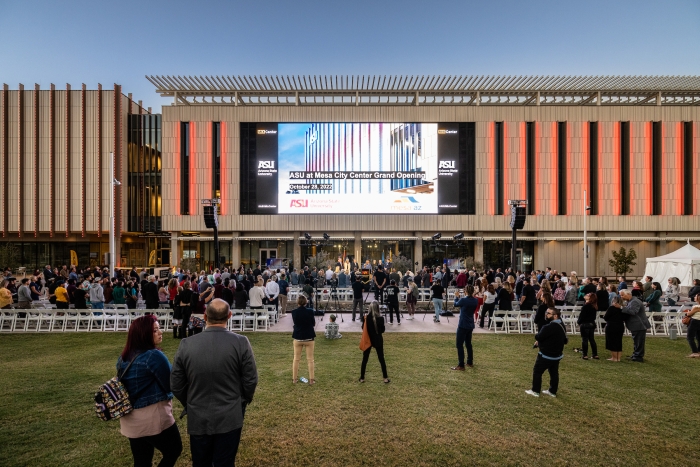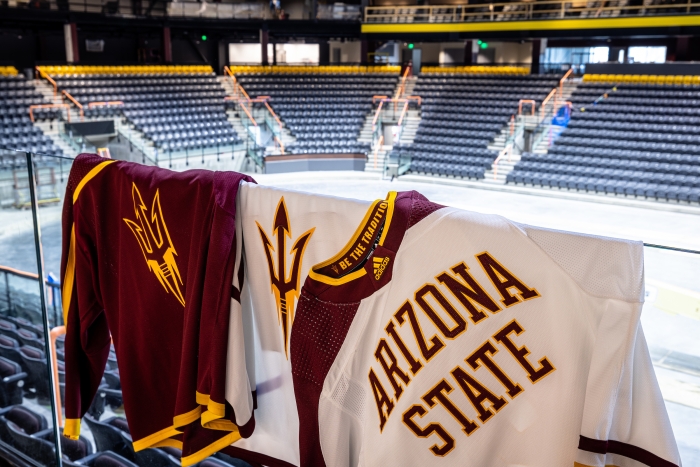State-of-the-art facilities highlight new upgrades to ASU campuses

The MIX Center in downtown Mesa contains high-tech sound-recording studios, control rooms, display areas, editing rooms, classrooms and office-support spaces. Photo by Charlie Leight/ASU News
Arizona State University completed more than 120 projects totaling more than $40 million during the summer and fall 2022 semesters.
Facilities Development and Management and its collaborators upgraded all ASU campuses and concluded work on two cutting-edge facilities. A new educational centerpiece in downtown Mesa, a mid-size arena for athletics and several Tempe campus additions highlight the new development.
“These projects showcase our investment in students, faculty, staff and Valley communities to provide welcoming environments for all to use,” said Alex Kohnen, Facilities Development and Management vice president. “The new facilities will support the ASU community for many years to come and contribute to the growth and success of their surrounding areas.”
Learn more about the recently completed construction projects:
Media and Immersive eXperience Center
A joint project between ASU and the city of Mesa, the MIX Center enhances innovation infrastructure with greater access to higher-education programs for local residents and increased activity in downtown Mesa.
The nearly 118,000-square-foot building provides large program areas, including:
- 280-seat screening theater.
- 80-seat screening room.
- Four sound stages.
- Enhanced immersion studio.
The building also contains high-tech sound-recording studios, control rooms, display areas, editing rooms, classrooms and office-support spaces. A 100-foot-wide high-resolution display on the building’s exterior faces the plaza with an event lawn for film screenings, sporting events and other community outings.
Located next to the MIX Center, the Studios at Mesa City Center are open to the public and provide support spaces for residents with entrepreneurial or business ideas.
The MIX Center houses academic units from the Herberger Institute for Design and the Arts, including The Sidney Poitier New American Film School. It also includes top-ranked digital media technology, worldbuilding, experience design and gaming programs from The Design School and the School of Arts, Media and Engineering, as well as from the Ira A. Fulton Schools of Engineering and the College of Global Futures.
Mullett Arena
Officially named in August and opened to the public in October, Mullett Arena is the new home for ASU hockey, wrestling and various community and entertainment events. The arena can accommodate concerts, lectures and large-scale meetings throughout the year.
Located in the center of the Novus Innovation Corridor, the 5,000-seat, state-of-the-art arena includes:
- 8,000 square feet for ASU’s locker room, weight room, players’ lounge and coaches’ offices.
- 20 luxury suites.
- Two ice sheets.
- Club lounge.
- Premium club seats.
“This arena will be an attractor as we bring together the university and our knowledge assets with the private sector,” said Morgan R. Olsen, ASU executive vice president, treasurer and chief financial officer.
The attached Mountain America Community Iceplex is accessible to students and serves the community with a practice and competition location for regional youth and adult hockey clubs.
Mullett Arena will host Arizona Coyotes home games for the 2022, 2023 and 2024 NHL seasons while the team develops its proposed new arena and entertainment district.
The construction of a two-story, approximately 15,000-square-foot annex adjacent to the arena accommodates NHL-quality home and away teams with:
- Dressing rooms.
- Fitness rooms.
- Nutrition stations.
- Training areas.
Demolition work
Recent demolitions on the west side of the Tempe campus pave the way for new academic and parking space development.
The demolition of Wilson Hall, constructed as a residence hall in 1956 along Orange Mall, will allow for a new five-story facility housing classroom, collaboration, instructional and office spaces to support academic programs’ growth and student success. The new building is the first section of a new academic district in the heart of campus, adding 19 state-of-the-art classrooms.
The Tempe Center and Tempe Center Annex buildings, acquired by the university in 1983, were demolished this summer. New developments in the area will include a parking structure, a future academic building with retail on Mill Avenue and a residence hall. The Mill Avenue Parking Structure, scheduled to be completed next summer, will add 1,205 parking spaces on six levels for the new Omni Tempe Hotel at ASU and the surrounding area.
Additional capital projects
The Engineering Center G Wing’s south exterior stairs were renovated, including an updated concrete infrastructure. Workers also installed new handrails and guardrails to meet current safety codes while matching the original handrail’s look.
On the Downtown Phoenix campus, workers installed 98 efficient water-source heat pumps in Health South.
In addition to many capital projects, Facilities Management completed numerous infrastructure projects — electrical, paint and maintenance — across all ASU campuses.
These projects are only part of existing ASU capital projects currently in planning, design or construction phases, including:
- Bateman Physical Sciences Center.
- Mill Avenue Parking Structure.
- Omni Tempe Hotel at ASU.
- Tempe’s new academic building.
Learn more about ASU’s past, present and future construction projects and follow Facilities Development and Management on Twitter at ASUfacilities.
More University news

ASU community exceeds goal, raises $835K for Valley of the Sun United Way
The Arizona State University community stepped up and raised over $835,266 for the Valley of the Sun United Way — exceeding the $800,000 goal for 2024.Of the total, $802,192.17 was raised through…

ASU launches online ocean futures undergraduate degrees
Our oceans make up three quarters of the planet’s surface and contain most of its biodiversity. Due to rapid and global changes, they are endangered — making more urgent a deeper knowledge of ocean…

ASU public affairs graduate programs rise to No. 11 in nation in US News & World Report’s 2025 rankings
Arizona State University rose to No. 11 nationwide for best graduate public affairs programs in U.S. News & World Report’s 2025 rankings, the magazine announced.The ranking, released April 8,…



